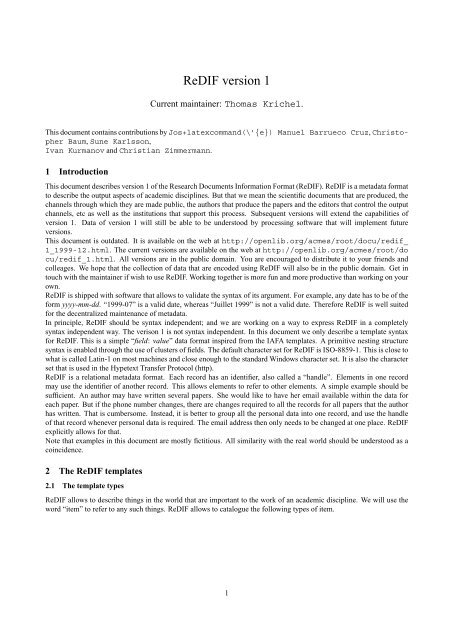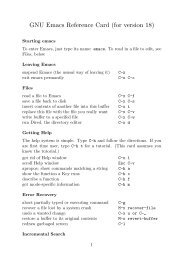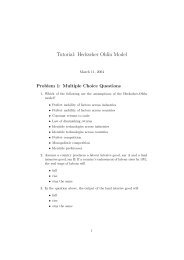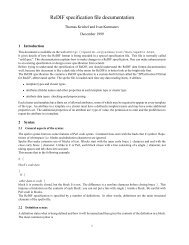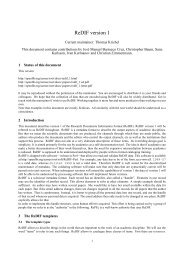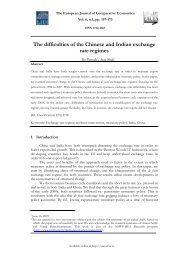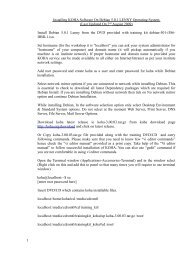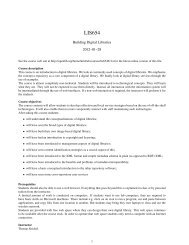A4 size paper - Open Library Society, Inc.
A4 size paper - Open Library Society, Inc.
A4 size paper - Open Library Society, Inc.
You also want an ePaper? Increase the reach of your titles
YUMPU automatically turns print PDFs into web optimized ePapers that Google loves.
ReDIF version 1Current maintainer: Thomas Krichel.This document contains contributions by Jos+latexcommand(\’{e}) Manuel Barrueco Cruz, ChristopherBaum, Sune Karlsson,Ivan Kurmanov and Christian Zimmermann.1 IntroductionThis document describes version 1 of the Research Documents Information Format (ReDIF). ReDIF is a metadata formatto describe the output aspects of academic disciplines. But that we mean the scientific documents that are produced, thechannels through which they are made public, the authors that produce the <strong>paper</strong>s and the editors that control the outputchannels, etc as well as the institutions that support this process. Subsequent versions will extend the capabilities ofversion 1. Data of version 1 will still be able to be understood by processing software that will implement futureversions.This document is outdated. It is available on the web at http://openlib.org/acmes/root/docu/redif_1_1999-12.html. The current versions are available on the web at http://openlib.org/acmes/root/docu/redif_1.html. All versions are in the public domain. You are encouraged to distribute it to your friends andcolleages. We hope that the collection of data that are encoded using ReDIF will also be in the public domain. Get intouch with the maintainer if wish to use ReDIF. Working together is more fun and more productive than working on yourown.ReDIF is shipped with software that allows to validate the syntax of its argument. For example, any date has to be of theform yyyy-mm-dd. “1999-07” is a valid date, whereas “Juillet 1999” is not a valid date. Therefore ReDIF is well suitedfor the decentralized maintenance of metadata.In principle, ReDIF should be syntax independent; and we are working on a way to express ReDIF in a completelysyntax independent way. The verison 1 is not syntax independent. In this document we only describe a template syntaxfor ReDIF. This is a simple “field: value” data format inspired from the IAFA templates. A primitive nesting structuresyntax is enabled through the use of clusters of fields. The default character set for ReDIF is ISO-8859-1. This is close towhat is called Latin-1 on most machines and close enough to the standard Windows character set. It is also the characterset that is used in the Hypetext Transfer Protocol (http).ReDIF is a relational metadata format. Each record has an identifier, also called a “handle”. Elements in one recordmay use the identifier of another record. This allows elements to refer to other elements. A simple example should besufficient. An author may have written several <strong>paper</strong>s. She would like to have her email available within the data foreach <strong>paper</strong>. But if the phone number changes, there are changes required to all the records for all <strong>paper</strong>s that the authorhas written. That is cumbersome. Instead, it is better to group all the personal data into one record, and use the handleof that record whenever personal data is required. The email address then only needs to be changed at one place. ReDIFexplicitly allows for that.Note that examples in this document are mostly fictitious. All similarity with the real world should be understood as acoincidence.2 The ReDIF templates2.1 The template typesReDIF allows to describe things in the world that are important to the work of an academic discipline. We will use theword “item” to refer to any such things. ReDIF allows to catalogue the following types of item.1
Thus the clusters below in this document often join an attribute prefix, e.g. “Author-”, with a cluster type name, e.g.“(PERSON*)”, between parenthesis.When writing clusters you should always remember about putting the key field first. For example, if you writeTemplate-Type: ReDIF-Paper 1.0Title: The CapitalAuthor-Email: K.Marx@highgate.london.ukAuthor-Name: Karl MarxAuthor-Phone: ...the Author-Email: attribute is not recognised, because at that point the Author-(PERSON*) cluster has not yet started.This will result in an error message or in your template being ignored. But the Author-Name: field that follows willstart the cluster, because “Name” is the key field of the PERSON cluster. Hence Author-Phone: field will be correctlyprocessed.Another example of potential mistakes is a case, when there are several objects to be described by a cluster type. Imaginethat we have two editors for a seriesEditor-Name: Adam SmithEditor-Name: David RicardoEditor-Email: Adam.Smith@classical.econ.orgEditor-Email: David.Ricardo@classical.econ.orgEditor-Workplace-Name: Institute of Classical EconomicsLooking at this data you can easily find out that Smith’s email address is Adam.Smith@classical.econ.org and that heprobably works for the Institute of Classical Economics as Ricardo does. But computer wouldn’t. For the computer, theline Editor-Name:DavidRicardo has started a new PERSON cluster, so it will eventually contain all the rest informationyou gave, including the email address of Smith. This mistake will not be identified as by any software only a human canfind this mistake.We believe that it’s enough for you to understand the general principles of clusters. We will fill in the details now.3.1 The ORGANIZATION and PERSON clustersThe ORGANIZATION cluster is defined by the following attributes:Name DescriptionName Name of organization, the keyName-English English translation of the name of organizationPostal Postal Address of organizationLocation Name of place where organisation is based, e.g. “Harare”Email Electronic mail address(es) of organizationPhone Telephone number(s) of organizationFaxFax number(s) of organizationHomepage URL of organisation’s home pageName is the key attribute of the organization cluster. It should always be put first.If you need example of organization cluster (where the organisation is in fact a provider):Provider-Name: Board of Governors of the Federal Reserve SystemProvider-Homepage: http://www.bog.frb.fed.us/pubs/feds/1996/Provider-Email: feds<strong>paper</strong>s@frb.govThe PERSON cluster is used to describe Homo Sapiens.NameDescriptionNameName of person, the keyWorkplace-(ORGANIZATION*) Organization in which person worksEmailElectronic mail address(es) of personFaxFax number(s) of personPostalPostal address of personPhoneTelephone contact informationHomepageURL of person’s home page4
Name is the key attribute of the person cluster. It should always be put first.Clusters can be nested, e.g., the (PERSON*) cluster can have a Workplace-(ORGANIZATION*) cluster inside it, as weillustrated in the Adam Smith example earlier.3.2 The FILE clusterThe FILE* cluster is used to describe a file that contains the resource that is being described, or a part of it.Name DescriptionURL Uniform Resource Locator of file, the keyFormat The format, e.g. “application/pdf” for PDF files, mandatoryFunction explains the function of file within the resourceSize The file <strong>size</strong>, by default in kilobytesRestriction A restriction placed on accessing the fileThese attributes may be not so trivial as in previous clusters, so we’ll describe each of them now.URL: This is the Uniform Resource Locator (URL) of the file on the Internet. The URL identifies an access protocoland a code that this protocol can use to retrieve the resource. Please refer to http://src.doc.ic.ac.uk/rfc/rfc1738.txt whencomposing a URL. Any whitespace in the URL will be ignored. Following RFC1783 any whitespace that follows a dashcharacter ’-’ is considered to be a mistake, because it is likely to have been introduced by word processing software. TheURL can be written over several lines, but do not break it after a dash. Use:File-URL:http://www.hhs.se/research/wpecofi/<strong>paper</strong>s/wp0121.pdf.zip ...File-URL: ftp://crefe.dse.uqam.ca/pub/cahiers/cah44.psThis is the key attribute of the file cluster. It should always be put first.Format: The contents of this field (all valid values) is restricted by a controlled vocabulary, with the MIME MultipurposeInternet Mail Extensions types. These types are specified in the RFC1521 at http://src.doc.ic.ac.uk/rfc/rfc1521.ps.gz.One complete and up to date list of these types is maintained by the IANA InternetAssigning Number Authority. But we have added some more types to the list since MIME does not cover allthe formats that we have in the database. The format of this field’s value is:File-Format:type/subtype[/subsubtype1][/subsubtype2]Here square brackets indicate that the expression inside is optional.type: The type will be one of text, application or image.subtype: The subtype is related to the type. When type is text we have:text/plaintext/htmltext/textext/latextext/bibtexWhen the the type is application we have:application/pdfapplication/postscriptapplication/mswordapplication/wordperfectapplication/dviapplication/lotusapplication/chiwriterapplication/gaussapplication/amiproapplication/mathematicaapplication/rtfapplication/envoyapplication/quattroproapplication/epsapplication/vnd.ms-excelapplication/hp5
application/fortranapplication/binapplication/prnWhen the type is image we have:image/jpegimage/gifimage/tiffThey are open lists that will be completed when documents with new formats will appear. If you wish to use a new type,please mail to the current author of this document./subsubtype1 & subsubtype2: To enumerate if the file is compressed and/or taped in some way. If one version is compressedand taped the file format will need two subsubtype parts. The subsubtype is optional. All files must have onetype and subtype, but they may not have a subsubtype. The subsubtypes can be:zipped: zip files are the most popular compressed files on the Internet. Usually they have the extension .zipgnuzipped: This is a gzip (GNU zip) file format. zip and gzip are two different programmes, although the actualcompression and decompression sources were written by the same people. zip is an archiver: it compresses several filesinto a single archive file. gzip is a simple compressor: each file is compressed separately. On Unix, gzip is mostly usefulin combination with tar. Usually they have the extension .gz.unixcompressed: Compressed with the standard Unix compress utility; usually they have the extension .Z.taped: an archive produced by the Unix tar utility. Tar is not a compression programme. It is used in Unix machines andprovides a way to store many files in a single archive, which can be kept in another Unix file. Usually the archive hasthe extension .tar.The subsubtypes can be combined:.../zipped.../gnuzipped.../gnuzipped/taped.../unixcompressed.../mac-binhex40.../unixcompressed/tapedThe attribute Format: is not repeatable and is case-insensitive.Function: This is the function of the file. It should be used when a file represents only some part of the whole document(or resource). And the field value indicates what particular part of the document is represented. For example, use:File-Function: Appendix 1...File-Function: Main text...File-Function: Example programmeIf the file is a complete rendering of the resource, the File-Function field should not be used. The field is not repeatablewithin the description of the same file.Size: The file <strong>size</strong>, by default in kilobytes. This attribute is not repeatable. Use:File-Size: 48...File-Size: 1788984 bytesRestriction: A restriction on the retrieval of a file. If the file can be retrieved by anybody with Internet access withoutany preliminary payment or registration, you should not use that field at all. Please do not use the field to make recommendationsof the type “please use outside working hours”, since as soon as there is a restriction on the file manyservices will be assuming that there is no public access to the file. If all files of a document are restricted, please use thefield Restriction: in the template of the resource, rather than repeating it for each file of the resource.Two examples for a complete file clusterFile-URL: http://rich.com/<strong>paper</strong>s/d_duck.absFile-Format: text/plainFile-Function: Abstract6
File-URL: http://rich.com/<strong>paper</strong>s/d_duck.wpFile-Format: application/wordperfectFile-Function: Main textFile-Size: 13982 bytes4 The ReDIF-Paper TemplateThis template concerns all <strong>paper</strong>s that are not published as part of a journal. We will be a bit more verbose here than inSection 5 where we describe other templates.4.1 The elements of the ReDIF-Paper templateAuthor-(PERSON*): This cluster-field is used to describe the person(s) that has created the document and is mainlyresponsible for its intellectual content. We recommend the name of the author(s) should be given in normalised formatlike “Lastname, Firstname” but the direct order is also acceptable.Omit titles, honours and others. If there are several authors, the information should be repeated for each author. This fieldis mandatory. That means that you should give at least one Author-Name: field with some value in each ReDIF-Papertemplate. Other information about the author is optional. Please do not overload the templates with author information.Use:Author-Name: Lang, WilliamAuthor-Email: wlang@lsuvm.sncc.lsu.eduAuthor-Workplace-Name: Center for Economic PerformanceAuthor-Name: Sturm, J.F.Author-Workplace-Name: Erasmus University Rotterdam,Econometric InstituteAuthor-Workplace-Postal: P.O. Box 1738, NL- 3000 DRRotterdam, The NetherlandsAuthor-Workplace-Homepage: http://www.eur.nl/few/ei/indexuk.htmlAuthor-Workplace-Email: eb-webmaster@few.eur.nlAuthor-Homepage: http://www.eur.nl/few/ei/stu.htmlContact-Email: This field is used to describe the a person that is a contact for the <strong>paper</strong>. This does not need to the bethe author’s email. You should not supply this field if you already have the author email. In some cases where the authordoes not wish her email to be in the <strong>paper</strong> information, this field should be used. Use:Contact-Email: Economics_Secretariat@hicks.gross-uni.yyTitle: The name of the document being catalogued. This includes any subtitles. This is a required field. Use:Title: A Theory of Gradual Trade LiberalisationAbstract: This is the abstract of the document. Although we do not require to have an abstract, but we stronglyrecommend to provide a detailed abstract, because it increases the chance of users finding your document within a fulltextdatabase. If you have a long abstract that has several paragraphs please split the paragraphs by the html 〈p〉 sequenceor repeat the Abstract: field for each paragraph.Classification-scheme: This is the classification number associated with the document. The scheme is a code for aclassification scheme. Allowed (registered) classification schemes and codes are listed in Appendix A.1. If you havedocuments, classified with some other scheme, just email us your suggestion, and we will register your scheme.If there are several classification numbers of the same classification scheme, they will be separated by a semicolon. Thisattribute is not repeatable, unless there are multiple schemes used. Example:Classification-JEL: C12; C30Keywords[-scheme]: These are keywords associated with the text. If there are several keywords they will be separatedby a semicolon. Scheme is the keywords scheme’s code but it can also be empty, to say that the keywords do not followa scheme. Keywords: should be used in that case. If you have some keywords schemes, we will register it for you inAppendix A.2.Example:7
Keywords: Competition; Consumer economics; Ethics; Philosophy of economicsKeywords: Accounting theory; Accounting principles; Financial accountingNote: Any other information that is relevant for the document. This can be its relation to other documents, a word ortwo about the history of the document etc. Use:Note: This was an invited <strong>paper</strong> to a special issue of the Polish...Note: This <strong>paper</strong> was written 5 years ago and we haven’t...Length: The length of a printed version of the document, usually in pages. This attribute is not repeatable. Use:Length: 29 pagesSeries: This is the series of the document. You can simply name the series here. In any case series information may alsobe extracted from the series templates of the core template files. This attribute is not repeatable.Number: The number of the <strong>paper</strong> within the series. This attribute is not repeatable.Availability: This field can be used to state if a <strong>paper</strong> is out of print. If the <strong>paper</strong> is on the net it should not be used. Itcan also be used to say how the get hold of the copy of the <strong>paper</strong>. This attribute is not repeatable. Use:Availability: out of printCreation-Date: The date at which the original document was created. The format should be as similar to the ISO8601:1988 Data elements and interchange formats – Information interchange – Representation of dates and times aspossible. This is yyyy[-mm[-dd]] where yyyy is the year, mm is the month and dd is the day. The notation yyyy[dd[mm]]may also be used. Note that the field should only contain the date of the creation, no other information. This field is notrepeatable. Use:Creation-Date: 1995-06-30Revision-Date: A date at which the document was changed. See previous paragraph for value format of this field - it isthe same as in Creation-Date. This field may be repeated.Revision-Date: 1995-06-30Price: That refers to the price of a printed copy of the document, when ordered through the ordering channels specifiedin the series template. Use:Price: $3.00 Surface, $4.00 Air (U.S. $)Price: 15 guilders by mail, free by ftpPublication-Status: This can be used to say if a modified version of the document exists, has been forthcoming, etc. ina commercial journal, book or other type of formal publication. It should always start with the word “published” or theword “forthcoming” (case insensitive). Use:Publication-Status: Forthcoming inComputational Statistics and DataPublication-Status: Published in Journal of Artificial IntelligenceResearch, Vol.3Publication-Status: Published in American Journal of Agricultural Economics,1995, vol. 77, no. 1. pp. 120-134.Publication-Status: Published by University of Arizona PressHandle: This is a required field in all cases. It’s really important. The Handle field content starts with the name of theauthority (organization), for example RePEc. The next element is a : and after that follows the code of the archive, thencode of the series finally the number of the <strong>paper</strong>. All these parts are : separated. Note that this field may not containwhitespace. If the Handle is written over several lines, the processing software will eliminate the whitespace characterson the lines boundaries. Use:Handle: RePEc:bon:bonnsf:a452Handle: RePEc:die:calsdi:9338Handle: RePEc:wop:censes:90-1Handle: RePEc:wop:comadt:08Handle: RePEc:wop:fedhbs:_0078
Each electronic document, described in RePEc system will have it’s own unique handle, which will allow to identify it(if we now the type of the document, e.g. Paper).template_type-Handle: This attribute cannot be used until we develop and introduce more template types for differentdocument types. But we will explain you idea for the future. If there is a different version of a document and this newversion has been described using the ReDIF templates in some system (may be RePEc or may be not), it is possibleto provide a reference to this another variant of the document by use of this field. You just need to specify a templatetypein the field and give a handle. For a example, imagine that we have defined the ReDIF-Book template and wehave a template of a <strong>paper</strong>, which was later published as a book. And this book also got to be described in a ReDIFtemplate. Then just can include Book-Handle field into the ReDIF-Paper template and supply the handle (value of thefield Handle) of the book. Restrictions on value of this field are the same like in case of bh(Handle). Use:Article-Handle: RePEc:chgooe:957701aBook-Handle: RePEc:aripr038The resolution process of these handles is not yet clear.Notification: to specify how new versions of the <strong>paper</strong> are announced.Restriction: A restriction on the retrieval of a <strong>paper</strong>. This is similar to the field of the same name in the File cluster. Ifthe <strong>paper</strong> can be retrieved by anybody with internet access, you should not use that field at all. Please do not use thefield to make recommendations of the type “please use outside working hours”, since as soon as there is a restriction ona <strong>paper</strong> many services will be assuming that there is no public access to it. If not all of the files that make up the <strong>paper</strong>are restricted, mention the restriction only in the FILE cluster of the restricted.4.2 Examples for <strong>paper</strong> templatesBelow there are several examples of ReDIF templates of type “ReDIF-Paper 1.0”. This is a simple document availableonly in PostScript format.Template-Type: ReDIF-Paper 1.0Author-Name: David CurrieAuthor-Name: Paul LevineAuthor-Email: p.levine@surrey.ac.ukAuthor-Name: Joeseph PearlmanAuthor-Name: Michael ChuiTitle: Phases of Imitation and Innovation in a North-South Endogenous GrowthModelAbstract: In this <strong>paper</strong>, we develop a North-South endogenous growth model toexamine three phases of development in the South: imitation of Northernproducts, imitation and innovation and finally, innovation only.In particular, the model has the features of catching up (andpotentially overtaking) which are of particular relevance to the Pacific Rimeconomies. We show that the possible equilibriadepend on cross-country assimilation effects and the ease ofimitation. We then apply the model to analyse the impact of R&Dsubsidies. There are some clear global policy implications which emergefrom our analysis. Firstly, because subsidies to Southern innovationbenefit the North as well, it is beneficial to the North to pay for some ofthese subsidies. Secondly, because the ability of the South to assimilateNorthern knowledge and innovate depends on Southern skills levels, theconsequent spillover benefits on growth make the subsidisingof Southern education by the North particularly attractive.Length: 26 pagesCreation-Date: 199607File-URL: ftp://ftp.surrey.ac.uk/pub/econ/WorkingPapers/surrec9602.psFile-Format: Application/postscriptHandle: RePEc:wop:surrec:9602This example from the Washington University Working Paper Archive. The <strong>paper</strong> has six different formats (postscript,postscript unixcompressed, pdf and so on). It’s author is Francisco F. R. Ramos from the Faculty of Economic, Universityof Porto. The original document was prepared using Microsoft Word as it said in the Note field.9
Template-Type: ReDIF-Paper: 1.0Title: Forecasting market shares using VAR and BVAR models: A comparison oftheir forecasting performanceAuthor-Name: Francisco F. R. RamosAuthor-Email: framos@fep.up.ptAuthor-Workplace-Name: Faculty of Economic, University of PortoNote: Type of original Document - Winword 2.0; prepared on IBM PC; to printon HP/Epson; figures: included. Word document submitted by ftpLength: 41 pagesKeywords: Automobile market; BVAR models; Forecast accuracy; Impulseresponse analysis; Marketing decision variables; Specification ofmarketing priors; variance decomposition; VAR modelsClassification-JEL: C11; C32; M31Abstract: This <strong>paper</strong> develops a Bayesian vector autoregressive model (BVAR)for the leader of the Portuguese car market to forecast the marketshare. The model includes five marketing decision variables.TheBayesian prior is selected on the basis of the accuracy of the outof-sampleforecasts. We find that our BVAR models generally producemore accurate forecasts of market share. The out-of-sample accuracyof the BVAR forecasts is also compared with that of forecasts froman unrestricted VAR model and of benchmark forecasts produced fromunivariate (e.g., Box- Jenkins ARIMA) models. Additionally,competitive dynamics of the market place are revealed throughvariance decompositions and impulse response analysis.Creation-Date: 19960123File-URL: http://econwpa.wustl.edu/econ-wp/em/<strong>paper</strong>s/9601/9601003.psFile-Format: Application/PostScriptFile-URL: http://econwpa.wustl.edu/econ-wp/em/<strong>paper</strong>s/9601/9601003.ps.ZFile-Format: application/postscript/unixcompressedFile-URL: http://econwpa.wustl.edu/econ-wp/em/<strong>paper</strong>s/9601/9601003.pdf.ZFile-Format: Application/pdf/unixcompressedFile-URL: http://econwpa.wustl.edu/econ-wp/em/<strong>paper</strong>s/9601/9601003.pdf.zipFile-Format: Application/pdf/zippedFile-URL: http://econwpa.wustl.edu/econ-wp/em/<strong>paper</strong>s/9601/9601003.pdf.gzFile-Format: application/pdf/gnuzippedFile-URL: http://econwpa.wustl.edu/econ-wp/em/<strong>paper</strong>s/9601/9601003.pdfFile-Format: application/pdfHandle: RePEc:bob:wuwpem:9601001This is an example of a document from the banking structure conference 1994 at the Federal Reserve Bank of Chicago.Although there is no published working <strong>paper</strong> series of that kind, we have created a imaginary series with code “fedhbs”.The document is available as PostScript in two parts, or as a zipped PostScript file.Template-Type: ReDIF-Paper 1.0Author-Name: Joseph P.HugesAuthor-Name: William LangAuthor-Name: Loretta J. MesterAuthor-Name: Choon-Geol MoonTitle: Recovering Techonologies That Account for GeneralizedManagerial Preferences: An Application to Non-Risk-Neutral BanksFile-URL: ftp://test.frbchi.org/pub/bsc/doc13a.psFile-Format: Application/PostScriptFile-Function: Main TextFile-URL: ftp://test.frbchi.org/pub/bsc/doc13b.psFile-Format: Application/PostScriptFile-Function: ChartFile-URL: ftp://test.frbchi.org/pub/bsc/doc13ps.zipFile-Format: Application/Postscript/zipped10
File-Function: Archive of Main text and chartHandle: RePEc:wop:fedhbs:_013Note that only Author-Name, Title and the Handle are mandatory in a template. It is however highly recommended thatyou should also give a Creation-Date, Abstract, Classification and/or Keywords.5 The Core templatesCore templates are templates that describe archives, mirrors and services.5.1 The Archive templateTemplate-type: ReDIF-Archive1.0 Each archive template must start with this declaration.Handle: This is the archive handle. The handle of the archive is the name of the authority (for example RePEc), a :and then the archive_identifier. The archive identifier has 3 letters. It should not have semantic contents. The archiveidentifier is proposed by the archive administrator and awarded by the authority.This field must not contain whitespace.Name: The name of the archive. This is a mandatory field.URL: url for the archive directory. This is a mandatory field. The URL should either point to a http of ftp site and shouldand with the three letter archive code.Homepage: the url of the archive’s homepage. This should point to a location that an end user may be interested in.Description: a description of the archive’s contentsMaintainer-Email: the email of somebody in charge of the archive (mandatory)Maintainer-Phone: phone number of some person in charge of the archiveMaintainer-Fax: phone number of some person in charge of the archiveMaintainer-Name: the name of a person that is in charge of the archiveClassification-scheme: Subject information for the archive, if applicable. Consult the same attribute in the Paper templateand Appendix A for description.Notification: To specify how new <strong>paper</strong>s in the archive are announced.Restriction: A restriction on the retrieval of all series in the archive. Similar to the same field in the <strong>paper</strong> template andin the file cluster. If the series can be retrieved by anybody with internet access, you should not use that field at all. Ifnot all of the series that make up the archive are restricted, mention the restriction only in the series templates of therestricted series.Templates examples:Template-type: ReDIF-Archive 1.0Handle: RePEc:bobName: Economics Working Paper Archive at WUSTLMaintainer-Email: bparks@wuecona.wustl.eduURL: ftp://econwpa.wustl.edu/bobTemplate-type: ReDIF-Archive 1.0Handle: RePEc:wopName: WoPEc ProjectMaintainer-Email: WoPEc@netec.mcc.ac.ukDescription: This archive collects information about holding of<strong>paper</strong>s on those sites that have not (yet) joined RePEc.URL: ftp://netec.mcc.ac.uk/pub/NetEc/RePEc/wopURL: http://netec.mcc.ac.uk/RePEc/wop/The archive template must be kept in a file called ???arch.rdf where ??? is the archive_identifier of the archive. Notethe slash that ends the last URL!5.2 The Series templateTemplate-type: ReDIF-Series1.0 Each series template must start with this attribute.Name: The name of the series is a mandatory field.Type: Each series may only contain one type of templates. This rule is called “Baum’s principle”. The Type: field isused to indicate the type. The default type is “ReDIF-Paper”. Other legal series types are “ReDIF-Software”, “ReDIF-Article”, and “ReDIF-Book”.11
Description: This should be a short description of the series’ content. Advertise your series here!Classification-scheme Subject for the series according to scheme scheme. Consult the same attribute in the Papertemplate and Appendix A for description.Keywords[-scheme]: Keywords for the series according to scheme scheme. Consult the same attribute in the Papertemplate and Appendix A for description.Editor-(PERSON*): This is the person responsible for the contents of the seriesProvider-(ORGANIZATION*): This is the organisation that supports the series.Publisher-(ORGANIZATION*): This is a synonym for “provider”. It is valid for historical reasons.Notification: To specify how new <strong>paper</strong>s in the series are announced.ISSN: The International Standard Serial Number for the series, if available.Maintainer-Email: the email address person in charge of the series’ files but not necessarily of its contents. Note thatthis field is mandatory, the maintainer will receive mail alerting her of any errors discovered.Maintainer-Phone: phone number of some person in charge of the seriesMaintainer-Fax: phone number of some person in charge of the seriesMaintainer-Name: the name of a person that is in charge of the seriesOrder-Email: email address where to send ordering requests toOrder-Homepage: http URL of a screen where orders can be placedOrder-Postal: Snail mail address where to order the <strong>paper</strong>Price: Price for all <strong>paper</strong>s in the series when ordered. Can be overwritten by a separate Price: field in the <strong>paper</strong>Restriction: A restriction on the retrieval of all <strong>paper</strong>s in the series. It has the same meaning as in File cluster and as inPaper template, but related to all the files of all the documents in that particular series.Handle: The handle of the series is the name of the authority (in our case RePEc, a : the handle of the archive, a : andthen the series_identifier. This attribute must not contain whitespace. The series_identifier is a six letter code. It shouldnot have semantic contents. The series code is awarded by the archive.Direct-Handle: The handle of another series that offers a better service about the <strong>paper</strong>s in a series. This should be usedif you have a large collection that comprises data about <strong>paper</strong>s by institutions that directly supply data to us. In that caseyou wish to signal that this direct data may be available. Processing software should check if the data for the direct seriesis available before dropping material from the series.Example:Template-type: ReDIF-Series 1.0Name: Computational EconomicsDescription: This is a series for economists who are computer nerds. Youcan not get more of an anorak than that.Maintainer-Name: Bob ParksMaintainer-Email: bparks@wuecona.wustl.eduHandle: RePEc:bob:wuwpcoTemplate-type: ReDIF-Series 1.0Name: Departmental Working PapersProvider-Name: East Carolina University, Department of EconomicsProvider-Homepage: http://ecuvax.cis.ecu.edu/~ecrothma/wp.htmMaintainer-Email: ecrothma@ecuvax.cis.ecu.eduHandle: RePEc:wop:eakjkl6 ReDIF templates for other publicationsIf a <strong>paper</strong> has been published in a journal, as a book or as a chapter in a book, you may wish to indicate that in thePublication-Status: field of the ReDIF-Paper template. The templates that follow are provided for archives that wishto provide more detailed information of the manifestations of a <strong>paper</strong>. We only give a summary of the meaning of thefields. Most of the fields are the same as in the ReDIF-Paper template and thus need no further explanation.The templates in this section are considered draft templates.6.1 The ReDIF-Article TemplateAn article is something that appeared in a journal or is forthcoming in a journal. This is a draft template for suchpublications.Template-Type: ReDIF-Article 1.0 The template must start with this field12
Other fields are like the <strong>paper</strong> template except that the following are not valid:Length: Series: Availability: Price: Revision-Date: Article-Handle:. Of course Paper-Handle: is valid.There are the following extra fields that the ReDIF-Article field has that are not in the ReDIF-Paper template. These arelisted here.Journal: Name of the journal, non-repeatableYear: Year of publication, non-repeatablePages: Pages in journal, non-repeatableVolume: Volume article appears in, non-repeatableMonth: Month journal issue is published, non-repeatableHandle: Handle of journal article. required.It is of the formRePEc:archive_identifier:series_identifier:article_codewhere archive_identifier is the 3 letter archive identifier, series_identifier is the six letter identifier of a series and :article_codeis the article code. The archive identifier should be the archive where the information is kept, if that is notknown put “jou”.As far as the series identifier is concerned, only series of articles are admissible here. In fact as far as ReDIF is concerned,a journal is a nothing else than a series of articles. It therefore has a series code like a <strong>paper</strong> series. It can be refereedto as a “journal code” in casual language, but the reader should keep in mind that as far as the structure of ReDIF isconcerned the journal is nothing else than a series.The article_code is a concatenation of qualifiers, separated by the colon character. Each qualifier is an attribute:valuepair. The attribute is represented by one letter only This is best understood by an example.RePEc:xxx:joinec:v:19:y:1985:i:Q1:p:67-84The qualifiers currently defined are the following. We list a name for the qualifier, the letter of the qualifier, a descriptionof values and a perl regular expression that that can be used to verify the syntax of the qualifier, as well as an optionaladditional check.Name: volumeLetter: vValue: any sequence of digitsRegEx: v[1-9][0-9]*Name: issueLetter: iValue: any sequence of digitsRegEx: i[1-9][0-9]*Name: yearLetter: yValue: any sequence of four digitsRegEx: y:([1-9][0-9]{3})Check: warn if $1 is higher then current year or earlier than 1500Name: pagesValue: number of page where article starts - number of page wherearticle endsRegEx: p:S*([1-9][0-9]*)-S*([1-9][0-9]*)Check: $1 should be smaller than $2here the S stands for “supplement”, just in case that the <strong>paper</strong> has not been published in the main issue.Name: issueValue: which issue within the year. If the issue is a month, then we give the English three letter start of the month:JAN, FEB MAR, APR, MAY, JUN, JUL, AUG, SEP, OCT, NOV, DEC. The numbers of the months are also allowedhere, but that is discouraged. If the issue is a quarter, we use Q1, Q2 etc. If the issue has a start date, putthat date like 04-01 for 1 April. Note that you need to put the - separator here because the date is otherwise mistakento be the number of the issue.There is no need to put an end date for this issue. You can repeat the issuequalifier if the physical issue covers several logical issues. SPE can be added to say it is a special editions, andS can be postponed for a supplement. RegEx: i:(($months\d*)($season[S]*)(Q[1234])(\d+)(\d\d-\d\d)) where $monthe=“(jan|feb|mar|apr|may|jun|jul|aug|sep|oct|nov|dec)”and $season=“(spr|sum|aut|win|spe)”13
Example:Template-Type: ReDIF-Article 1.0Title: Productivity Spillovers from FDI in the UruguayanManufacturing SectorAuthor-Name: Kokko, AriAuthor-Workplace-Name: Dept. of Economics, Stockholm Schoolof EconomicsAuthor-Workplace-Postal: Stockholm School of Economics,P.O. Box 6501, 113 83 Stockholm, SwedenAuthor-Name: Tansini, RubenAuthor-Name: Zejan, MarioAuthor-Workplace-Name: Dept. of Economics, Stockholm Schoolof EconomicsAuthor-Workplace-Postal: Stockholm School of Economics,P.O. Box 6501, 113 83 Stockholm, SwedenJournal: Journal of Development StudiesPages: 602-611Volume: 32Year: 1996Publication-Status: PublishedHandle: RePEc:jou:devstu:v:32:y:1996:i:Q1:p:602-611What happens if you wish to provide data about the formal publication, i.e., within a journal, of a <strong>paper</strong> for whichyou have ReDIF-Paper information. This is called Sune’s problem. The basic status is that it is not possible for you toprovide information about an article that you have published in a journal. It is for the journal or some agent of the journalto provide that information, because all the information about all the articles has to be kept together in once directory.However, you can give the Article handle, and a ReDIF literate individual should be able to find the information.6.2 The ReDIF-book TemplateThis is a drafter templateTemplate-Type:ReDIF-Book1.0 The template must start with this field.Title: Title of book, required, non-repeatableAuthor-(PERSON*): Person cluster for each author, at least one cluster is required.Abstract: Abstract.Classification-scheme: non-repeatableKeywords[-scheme]: non-repeatablePublisher-(ORGANIZATION*): Organization cluster for Publisher, required.Year: Year of publication, required for published books, non-repeatableMonth: Month of publication, non-repeatable.Volume: Volume in multi-volume works, non-repeatableEdition: 2nd, 3rd etc., non-repeatable.Series: If the book is part of a series, non-repeatable. For example Series: Springer Lecture Notes in Mathematics,volume 234Editor-(PERSON*): Editor of series.ISBN: ISBN of the book, non-repeatable.Publication-Status: One of ’Published’ or ’Forthcoming’, non-repeatable, Published is assumed if field is not present.Note: Any additional informationtemplate-Handle: Handle of Paper, Article or Chapter template if published in several places.Handle: Required. See comment for Handle: in Article template. Sune Karlsson has suggested the naming schemeRePEc:Archive:Series:boknnnn.Required fields are Title:, Author-Name:, Handle: and Publisher-Name:. For published (as opposed to forthcoming)<strong>paper</strong>s Year: is also required.6.3 The ReDIF-Chapter TemplateThis template is for chapters with individual authors in a collection of <strong>paper</strong>s. Examples are <strong>paper</strong>s published in conferenceproceedings, reprint volumes and Festschrifts.14
Template-Type: ReDIF-Chapter 1.0 The template must start with this fieldTitle: Title of chapter, required, non-repeatable.Author-(PERSON*): Person cluster for each author, at least one cluster is required.Abstract: Abstract.Classification-scheme: non-repeatableKeywords[-scheme]: non-repeatableBook-Title: Title of volume, required, non-repeatable.Editor-(PERSON*): Editor cluster for each editor, at least one cluster is required.Year: Year of publication, required for published <strong>paper</strong>s, non-repeatable.Month: Month of publication, non-repeatable.Pages: Pages in volume, non-repeatable.Chapter: Chapter in volume, non-repeatable.Volume: For multi-volume works, non-repeatable.Edition: 2nd, 3rd etc, non-repeatable.Series: Series that volume is part of, non-repeatable.ISBN: ISBN of volume, non-repeatable.Publication-Status: One of ’Published’ or ’Forthcoming’, non-repeatable, Published is assumed if field is not present.Note: Any additional information.Paper-Handle: Handle of working <strong>paper</strong> template, non- repeatable-Handle: Handle of Article, Book or Chapter handle if published in several places.Handle: Required. Suggested scheme: RePEc:Archive:Series:chpnnn.Required fields are Title:, Author-Name:, Book-Title:, Editor-Name:, Handle: and Provider-Name: or Sponsor-Name:. For published <strong>paper</strong>s Year: is also required.Example:Template-Type: ReDIF-Chapter 1.0Title: Modelling Economic Relationships with SmoothTransition RegressionsAuthor-Name: Teräsvirta, TimoAuthor-Workplace-Name: Department of Economic StatisticsAuthor-Workplace-Postal: Stockholm School of Economics, Box6501, 113 83 Stockholm, SwedenBook-Title: Handbook of Applied Economic StatisticsEditor-Name: Giles, D.E.A.Editor-Name: Ullah, A.Publisher-Name: DekkerPublication-Status: ForthcomingPaper-Handle: RePEc:hhs:hastef:0131Handle: RePEc:hhs:hastef:chp01316.4 The ReDIF-Software TemplateThis is a draft template.Template-Type: ReDIF-Software 1.0 The template must start with this fieldTitle: Name of the software, required, non-repeatableProgramming-Language: this is a controlled vocabulary identifier for the language used. At the moment the onlyallowed value are “stata”, “Mathematica”, “RATS”, “GAUSS”, “MATLAB”, “FORTRAN”, “C”, “Ox” and “perl”. Allthese identifiers are case insensitive.Author-(PERSON*): Person cluster for each author, at least one cluster is required.Abstract: Abstract to describe the principal function of the software.Number: The version number of the softwareKeywords: keywords for the software,Size: <strong>size</strong> of software, usually the number of lines of codeCreation-Date: The date at which the original code was created. The format should be as similar to the ISO 8601:1988Data elements and interchange formats – Information interchange – Representation of dates and times as possible. Thisis yyyy[-mm[-dd]] where yyyy is the year, mm is the month and dd is the day. The notation yyyy[dd[mm]] may also beused. Note that the field should only contain the date of the creation, no other information. This field is not repeatable.Use:15
Creation-Date: 1995-06-30Revision-Date: A date at which the document was changed. See previous paragraph for value format of this field - it isthe same as in Creation-Date. This field may be repeated.Revision-Date: 1995-06-30Note: additional informationRequires: indicates that a certain package version, compiler, or operating environment is needed.Handle: Handle, of the form RePEc:Archive:Series:NumberRequired fields are Title:, Author-Name: Programming-Language: and Handle:.Example:Template-Type: ReDIF-Software 1.0Title: MKSTRSN: Stata modules to format Social Security number variablesAuthor-Name: William GouldAuthor-WorkPlace-Name: Stata CorporationAuthor-WorkPlace-Postal: Stata Corporation, 702 University Drive East,College Station, Texas 77840 USAAuthor-Email: wgould@stata.comProgramming-Language: StataAbstract: mkstrsn and mkdashsn make string variables (without and withdashes,respectively) from a nine-digit variable containing a SocialSecurity number. The commands have the syntax mkstrsn newvar oldvarand mkdashsn newvar oldvar.Series: Statistical Software ComponentsNumber: S328601Creation-Date: 19971212Length: 39 linesClassification-JEL: C87File-URL: ftp://ftp.bc.edu/pub/user/baum/statal/mkstrsn.adoFile-Format: text/plainFile-Function: program codeFile-URL: ftp://ftp.bc.edu/pub/user/baum/statal/mkdashsn.adoFile-Format: text/plainFile-Function: program codeHandle: RePEc:boc:bocode:S3286017 ReDIF templates for physical entities7.1 The ReDIF-Institution templateThis template concerns information about institutions. This information can be used in the other templates by a call tothe appropriate institution handle. The template has to be in a directory called inst.The elements of the ReDIF-Institution templateThere are three types of clusters: Primary, Secondary and Tertiary. This is to take account of some institutions beingsubdivision of others. Examples are: University of London/London School of Economics/Financial Markets Group,Federal Reserve Bank of Minneapolis/Research Department, Government of Zambia/Ministry of Finance. These threeclusters are organized like the ORGANIZATION cluster described in section 3.1, with the addition of Location andName-English elements. An example is:Primary-Name: Universite des Grands EspoirsPrimary-Name-English: University of Grand HopesPrimary-Location: Panava-les-FlotsSecondary-Name: Departement d’EconomieSecondary-Name-English: Department of EconomicsSecondary-Email: eco@uge.eduSecondary-Homepage: http://www.eco.uge.edu/16
Secondary-Phone: (+567)3466356An additional element is:Handle: This has to be a 7 letter handle, the last two characters being the ISO 3166 country codes (us for the UnitedStates, ea foe associations and societies). Archive edi (EDIRC) already has a lot of institutional information. Forupdating information about an institution already listed in EDIRC, please use the same handle! Information at otherarchives overrides the information of the edi archive. Examples:Handle: RePEc:edi:imfffusHandle: RePEc:edi:mofgvzmHandle: RePEc:fmg:fmlseukComplete templates may therefore read:Template-Type: ReDIF-Institution 1.0Primary-Name: Government of BahrainPrimary-Location: ManamaSecondary-Name: Bahrain Monetary AgencySecondary-Homepage: http://www.bma.gov.bh/Handle: RePEc:edi:bmagvbh8 The administrative templatesThese templates are not intended for the providers of archives.8.1 The Mirror templateThe mirror template describes what kind of mirror you are running on your machine. You are allowed to mirror anyseries and archive you wish. What you are mirroring is described in the mirror template. It contains information that isread by the scripts that build your mirror.Template-type: ReDIF-Mirror1.0 Each mirror template must start with this declaration.Archive-Handle: This is the archive identifier of your archive. This is a mandatory field. Each mirror must belong to anarchive.User: For Unix machines only. This is the name the user that that owns the archive. We recommend that you give thatyou use the name “adrepec”. This is also the default username. Why the “ad” stands in front of the “repec” is a longstory that does not really belong here.Group: For Unix machines only. The name of the group of the user that that owns the archive. The default is “adrepec”.Directory: The path for the directory of the mirror on your machine, i.e. the place where the directories of the archiveslive. The path can either be the full path or a relative path from home of the user that owns the archive. Note thatthis directory is not the RePEc directory where your own archive lives, but the place where a series of remote archivedirectory lives. We recommend that this path ends with /remo.Description: any description that you may add to the information about the mirrorMaintainer-Email: the email of somebody in charge of the mirror (mandatory)Maintainer-Phone: phone number of some person in charge of the mirrorMaintainer-Fax: fax number of some person in charge of the mirrorMaintainer-Name: the name of a person that is in charge of the mirror.Machine: The DNS name or number on which the mirror is running. This is a mandatory field.The next four fields should be handled with care. At most one of them may appear.Archives-<strong>Inc</strong>luded: a list of archives handles that are included in the mirror. The list may be separated by any characterexcept letters and colons. If this field does not appear, the mirror will include all archives known to RePEc. If it appears,the mirror will include only the series listed. Thus for example, if you leave that attribute blank, the mirror will mirrornothing.Archives-Excluded: a list of archives handles that are excluded in the mirror. The list may be separated by any characterexcept letters and colons. If this field does not appear, the mirror will include all archives known to RePEc. If it appears,17
the mirror will exclude the archives that are listed. Thus for example, if you leave that attribute blank, the mirror willmirror everything.Series-<strong>Inc</strong>luded: a list of series handles that are included in the mirror. The list may be separated by any characterexcept letters and colons. If this field does not appear, the mirror will include all series known to RePEc. If it appears,the mirror will include only the series listed. Thus for example, if you leave that attribute blank, the mirror will mirrornothing.Series-Excluded: a list of series handles that are excluded in the mirror. The list may be separated by any characterexcept letters and colons. If this field does not appear, the mirror will include all archives known to RePEc. If it appears,the mirror will exclude the archives that are listed only the series listed. Thus for example, if you leave that attributeblank, the mirror will mirror everything.ReDIF-only: This field may be used to tell mirroring software only to mirror files with the extension tt.rdf). The valueof the field will be ignored. If you wish to mirror everything in an archive please do not use this field.ExamplesTemplate-type: ReDIF-Mirror 1.0Archive-Handle: RePEc:jkbMachine: ftp.play.eduUser: adrepecGroup: usersDirectory: RePEc/remoLocation: Southern PlaylandDescription: Small mirror of two game theory seriesMaintainer-Email: J.von.Neumann@smart.eduSeries-<strong>Inc</strong>luded: RePEc:bon:bonsfa RePEc:bob:wuwpgaTemplate-type: ReDIF-Mirror 1.0Archive-Handle: RePEc:surMachine: gretel.econ.surrey.ac.ukDescription: A full mirror on a private machineUser: adrepecGroup: usersDirectory: /usr/local/ftp/pub/RePEc/remoLocation: Guildford, Surrey, EnglandMaintainer-Name: Thomas KrichelMaintainer-Email: T.Krichel@surrey.ac.uk8.2 The authority templateThis is a draft template.Template-type: ReDIF-Mirror1.0 Each authority template must start with this declaration.Url: The url where the authority is based. RequiredHandle: The handle of the authority. RequiredExamplesTemplate-type: ReDIF-Authority 1.0Url: http://netec.mcc.ac.uk/pub/RePEcHandle: RePEcAData on secondary instancesSome metadata relating to preprints contain information on where the <strong>paper</strong> has been published. If a complete recordfor this instance is provided by the publisher of the formal channel, a link to that record may be included in the <strong>paper</strong>.However in most cases only partial and non-authoritative information about this instance in available. If that data is just achain of characters, the Publication-Status field can be used. If that data is itself fielded, the MANIFESTATION clustershould be used.18
A.1 The MANIFESTATION clusterAny instance where the resource or something very similar is formally published is called a manifestation of the resource.The manifestation cluster is used to deal with that.Type: Each manifestation template must start with this field. This field has a controlled vocabulary. It can take thefollowing values.value explanationprar Published refereed journal articlepuar Published unrefereed journal articlepboc Published book chapterpcpa Published conference <strong>paper</strong>pcpo Published conference posterfrar Refereed journal article in pressfboc Book chapter in pressfcpa Refereed conference <strong>paper</strong> in pressaupa Author archived Unrefereed <strong>paper</strong>dupa Departmental archive unrefereed reportcupa Unpublished conference <strong>paper</strong>cupo Unpublished conference posterpnew Published News<strong>paper</strong>/magazine articleDate: A date associated with the manifestationTitle: The title of the manifestation. This should be similar to but not necessarily identical with the title of the resource.Pages: The pagination of the manifestation, of the form number of the first page - number of the last page.Publisher-ORGANIZATION: The publisher of the manifestation, an organization cluster.Conference-Date: the date of the conference where the manifestation was presented. It must be of the form yyyy-mmdd-yyyy-mm-dd.Dates may be of a simpler form like “1999”, only the first yyyy is required.Conference-Title: The title of the conference.Conference-Location The location of the conference.Conference-Editor-PERSON: A person cluster for each editor of the conference proceedings.Journal-Title: The title of the journal in which the manifestation appeared.Journal-Volume: The volume of the journal in which the manifestation appeared.Journal-Year: The volume of the journal in which the manifestation appeared.Journal-editor-PERSON: Personal data for the editor of the journal where the manifestation appeared.Book-Chapter: a free text indication about the chapter in the book the manifestation corresponds to.Book-Volume The volume of the book, independly if the manifestation is a chapter in the book or the book itselfBook-Editor-PERSON: This is personal data for the editor of the book where the chapter was produced.AClassification and keywords schemesA.1 Classification scheme(s)Classification-Ila: The classification scheme proposed in the NASA TechReport TM-1998-208955.Classification-JEL: The classification system of Journal of Economic Literature. It’s usually used to classify economicstexts. For more info see http://www.aeaweb.org/journal/elclasjn.html. Several code may be given separated by colon,semi-colon or blanks.Classification-ACM-1998: The classification scheme used by the Association for Computing Machinery,in its version of 1998. Several codes may be given separated by colon, semi-colon or blanks.Classification-ACM-1991: The classification scheme used by the Association for Computing Machinery,in its version of 1991. Several codes may be given separated by colon, semi-colon or blanks.Classification-ACM-1964: The classification scheme used by the Association for Computing Machinery,in its version of 1964. Several codes may be given separated by colon, semi-colon or blanks.Classification-MSC-1991: The Mathematics classification scheme devised by the American Mathematical <strong>Society</strong>,in its version of 1991. Several codes may be given separated by colon, semi-colon or blanks.Classification-MSC-2000: The Mathematics classification scheme devised by the American Mathematical <strong>Society</strong>,in its version of 2000. Several codes may be given separated by colon, semi-colon or blanks.19
A.2 Keywords scheme(s)Attent: This is a thesaurus (list of controlled keywords) which was used for a database “Attent: Research Memoranda”.This database, as well as the thesaurus, is produced and maintained by Tilburg University <strong>Library</strong>. “Attent: ResearchMemoranda” only includes economic working <strong>paper</strong>s. The thesaurus includes economic and mathematical keywords.For further details contact Corry Stuyts .20


